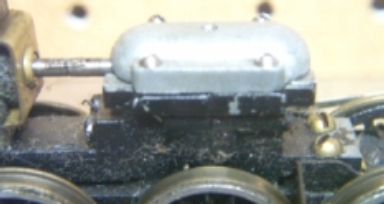For the sake of historians, Mantua is not new to gear boxes. Their earliest design, using a Pittman DC-71, was applied to a Reading G-1 pacific and P-7 Atlantic around 1950.

Note: Adjust brightness and contrast for optimum viewing.
Old gear box in Pacific with DC-71.
The idler box was screwed to the frame and a cantilever like bar screwed to it, mounted the motor. The novel universal was a thin strip of brass inserted into slits in the shaft ends. The jutting strip ends were formed into an "S" around the shafts as a retainer. Although very expensive by 1950 standards at just under $ 50, they were and still are excellent performers.
Over the years, Mantua made many changes in locos. Being economical, dies were often only modified and remnants of older designs were still present. The evolution of a Mikado frame is shown here.

Note: Adjust brightness and contrast for optimum viewing.
Retrofit gear box mounted on
Mikado frame with evidence of 3 phases in motor mount layout.
Just visible at the left end, are the original ramps and pole piece saddle for an angle mount Pittman DC-71, geared to the last driver. The gear hole on the rear axle is filled in. By cutting a new hole, The geared axle could be moved back to accommodate a DC-71.
To cut costs during the Tyco era, a much lower powered and faster PM-1 PM-1 motor was geared through the second axle. Just to the right of the rear axle, 2 posts aligned the rear of the motor and allowed it to slide fore and aft for gear mesh adjustment.
After the Tyco divorce, a new MG-81 motor was introduced with characteristics similar to the DC-71, but with a flat mount. Power Drive locos had the new motor and an angled gear box along with an odd shaped plastic "wedge" to raise and tilt the motor. A hole in the rectangular section slipped over the front motor screw and the rectangular stud cast into some frames. The gear box is to the right of the wedge. In some cases, using the Retrofit kit required drilling new holes or existing holes clear through. Some slight filing and adapter wedge adjustments had to be made to accommodate various frames. Rubber tubing connected the shafts. The net effect was a great improvement over the PM-1 in both power and speed.
The parts can be used in other applications easily. The gear shaft is standard 3/32" with bearings, permitting the use of other gears with some filing or shimming at the base to adjust mesh.
Used on loggers and Atlantics , as parts an idler gear box is available . The designed ratio is 27:1, but with some juggling, others can be used. The shaft and bearings are 3/32". As with all idlers a reverse worm gear is required in the train.

Note: Adjust brightness and contrast for optimum viewing.
Newer gear box in Atlantic with MG-81.
Although over powered, the combination works very well, when enough weight is added to pull 8 or ten passenger cars. On evaluation, the newer can motors slow the Atlantic to the point where they can not attain 129 SMPH as done with the PRR 7002. Power is not sufficient for larger locos, when properly weighted to handle long trains.
Although over powered, the combination works very well, when enough weight is added to pull 8 or ten passenger cars. On evaluation, the newer can motors slow the Atlantic to the point where they can not attain 129 SMPH as done with the PRR 7002. Power is not sufficient for larger locos, when properly weighted, to handle long trains.

Note: Adjust brightness and contrast for optimum viewing.
Bare gear boxes.
Retrofit.
Newer with idler gear barely showing at bottom.
With some shimming or filing, either can accept other worms and wheels.
BACK TO REGEAR
BACK TO REPOWERING
